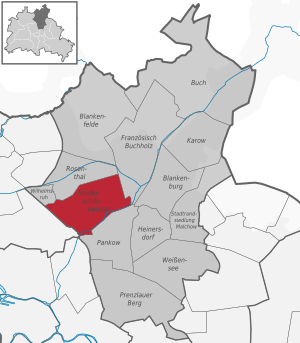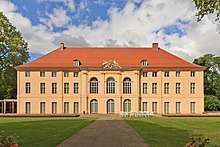Berlin-Niederschönhausen
|
Niederschönhausen district of Berlin |
|
|---|---|
| Coordinates | 52 ° 35 ′ 0 ″ N , 13 ° 24 ′ 0 ″ E |
| surface | 6.49 km² |
| Residents | 31,996 (Dec. 31, 2019) |
| Population density | 4930 inhabitants / km² |
| Post Code | 13156 |
| District number | 0311 |
| structure | |
| Administrative district | Pankow |
| Locations | |
Niederschönhausen is a part of Berlin in the Pankow district . The urban area is characterized by old villas and tenement houses. Schönhausen Palace is also located here . Until the founding of Greater Berlin in 1920, Niederschönhausen was an independent rural community in the Niederbarnim district in Brandenburg .


The surname Pankow-Schönhausen is a reference to the neighboring district of Pankow . Representatives of the old Federal Republic viewed and referred to the district of Niederschönhausen metonymically as Pankow , because a large number of GDR politicians lived here until 1960 until they moved to the Bernau forest settlement .
history
development
The lack of late Slavic settlement remains suggests that Niederschönhausen developed as a street village . There are first indications of settlement from around 1230, to which a manor was added later in the southern half . The village church in Niederschönhausen was built around 1250 . The village was first mentioned in the land register of Charles IV of 1375, namely as Schonenhusen inferior and Nydderen Schonhusen . It had 48 hooves , including 4 parish hooves ( Wedemhof ) and 10 knight hooves , as well as a jug . In 1450 there were 52 hooves because 2 church hooves were added. The knight's hooves and the right to surrender to the Hüfner changed several times between several well-known Brandenburg aristocratic families. In 1691, Elector Friedrich III. the village. A simple castle built at the end of the 17th century was representative converted in 1704. Friedrich II. Gave the Niederschönhausen Castle to his wife in 1740, who lived in it until 1797, apart from the King.
" Nieder-Schönhausen , Kirchdorf in the Nieder = Barnimer district, 1 m north of Berlin, in front of the Schönhauser Thore , has a royal palace with a large park [...] and many Berliners' country houses."
Since the 20th century
The law on the formation of the urban community of Berlin ( Greater Berlin Law ) passed by the Berlin magistrate in 1920 led to the creation of 20 administrative districts in which the surrounding villages were incorporated. This law allowed the new administrations to subdivide their territory into local districts . According to the council minutes of Berlin-Pankow (the XIX administrative district) of July 29, 1920, the villages of Blankenburg, Buch, Niederschönhausen, Rosenthal, Wilhelmsruh and Pankow merged to form the 19th district, whose administration began on March 18, 1921.
With the merger, the infrastructure was improved, among other things, the route of Wollankstrasse was given a changed route, the course of the Panke was regulated, the purchased Rosensche Park was designed in Niederschönhausen and a morgue was built in Blankenburg .
During the time of National Socialism , the General Building Inspector of Berlin had decided on an area of interest plan, which led to the existing housing development becoming more concentrated and further residential areas in Niederschönhausen being opened up. However, this was also the time when many Jews sold their properties. In the district files, transfers of ownership around Uhlandstrasse, Lindenberger, Blankenburger and Waldstrasse are particularly frequent.
In 1949 the castle and the nearby Mayakowskiring with the residential villas of the GDR politicians became the political center of the GDR. The fenced and guarded area was also called the “town” by the residents. With the move to the Waldsiedlung near Wandlitz in 1960, the area also opened up to the general population from 1973 .
In the turn of time 1989/1990 met in the outbuildings of the castle of the Round Table . In addition, essential parts of the two-plus-four negotiations took place here.
geography
Niederschönhausen is located north and northwest of the center of Pankow - the western border is marked by the Berlin Northern Railway . Starting from the northern urban development of the Berlin city center ( Prenzlauer Berg ) and Pankow, it goes over into the corridors of the Schönholzer Heide to the northern outskirts.
Locations
In addition to the eponymous location, the locations are part of Niederschönhausen
- Schönholz ,
- Mayakowskiring and
- Northrend .
Development
When the village of Niederschönhausen was incorporated into Berlin, there was a waterworks with a water tower on Waldstrasse, which was built in 1903 . Technology and tower were removed by 1928. The main building has been preserved and serves as a private residence.
Niederschönhausen is characterized by a development with villas and tenement houses, which were mainly built around 1910 to the 1920s. The Schönhausen Palace is also located here , one of the few palace buildings in Berlin that survived the Second World War unscathed. In the 18th century the palace was owned by Queen Elisabeth Christine , the wife of King Frederick II. Significant parts of the original furnishings have been preserved from this period. During the GDR era, it was initially the seat of Wilhelm Pieck , the GDR President , and later the government guest house. As the location of the central round table and the two-plus-four talks that prepared for German reunification , Schönhausen Palace played a special historical role after 1989. The Federal Academy for Security Policy (BAKS) is now located in the outbuildings of the palace complex . After extensive renovation, the palace has been open to regular visitors as a museum since 2009.
The Johannes-R.-Becher-Haus , as it was officially called until 1990, is located in Mayakowskiring. The writer Johannes R. Becher lived there until his death, and among other things wrote the text for the GDR national anthem . In the 21st century a private company is housed in the house.
Around 500 meters west of Mayakowskiring , the artist's settlement Erich Weinert was built around Street 201 from 1950 onwards, following a resolution by the GDR government .
Niederschönhausen is a green district: The Schönholzer Heide , the Brosepark , the castle park, the Bürgerpark and the Pankow III cemetery are located here.
In addition, Niederschönhausen is one of the few districts in the Pankow district that still has a cinema : The Blue Star on the corner of Hermann-Hesse- and Waldstraße. Max Skladanowsky comes from Niederschönhausen. In 1895 he applied for a patent for his Bioscop projection apparatus and first screened his self-made films on November 1, 1895 in the Varieté Wintergarten . He is considered a cinema pioneer alongside the brothers Auguste and Louis Lumière and Thomas Alva Edison . He is also buried in Niederschönhausen, where he lived on Waldowstrasse - in Cemetery IV on Herthaplatz. The city of Berlin's grave of honor for Carl von Ossietzky is also located there . He died in the Nordend Hospital , which was demolished in early 2006. In 1947, Hans Fallada was treated in the school building on the corner of Blankenburger Strasse and Buchholzer Strasse, which was temporarily used as a hospital . He died here in the same year.
Church buildings of both denominations are represented in Niederschönhausen : the Evangelical Peace Church and the Catholic Church of St. Maria Magdalena .
traffic
The following bus and tram lines run through the district of Niederschönhausen (as of 2016):
- 107 S + U Pankow or Niederschönhausen, Hermann-Hesse-Strasse / Waldstrasse. - S Hermsdorf or Arkenberge
- 124 Buchholz -West, Aubertstraße - Alt-Heiligensee
- 150 U Osloer Strasse - S book
- 155 S + U Pankow - Wilhelmsruh , Fontanestrasse
- 250 (U Franz-Neumann-Platz -) U Vinetastraße , Niederschönhausen, Buchholzer Straße, U Vinetastraße (- U Franz-Neumann-Platz)
- M1 Mitte , Am Kupfergraben - Niederschönhausen, Schillerstraße or Rosenthal Nord (in night traffic to Schillerstraße)
The federal highway 96a , which runs through the district, is of particular importance for road traffic .
See also
- List of streets and squares in Berlin-Niederschönhausen
- List of cultural monuments in Berlin-Niederschönhausen
- List of stumbling blocks in Berlin-Niederschönhausen
literature
- Hans-Jürgen Rach: The villages in Berlin. Berlin 1990, ISBN 3-345-00243-4 .
Web links
Individual evidence
- ↑ JGA Ludwig Helling (ed.): Historical-statistical-topographical pocket book of Berlin and its immediate surroundings. HAW Logier, Berlin 1830. Online at google-ebooks. Retrieved December 20, 2011
- ↑ A Rep 049-08 No. 4 in the Berlin State Archives : Record of the meeting with the representatives of the community or manor districts of the future district office on July 19 and 29, 1920 ; Minutes of September 2, 1920; Decision of the Berlin magistrate , published in the municipal newspaper No. 18 of May 1, 1921; accessed on May 22, 2017.
- ↑ A Rep 049-08 No. 4 in the Landesarchiv Berlin : Record of the meeting with the representatives of the community or manor districts of the future district office on July 19 and 29, 1920 , viewed on May 22, 2017.
- ↑ a b A Rep 049-08, 240-244. Housing approval process in Niederschönhausen 1938–1941 .
- ^ Waterworks and water tower in Uhlandstrasse . In: pankowerchronikdot.de; accessed on May 23, 2017.





